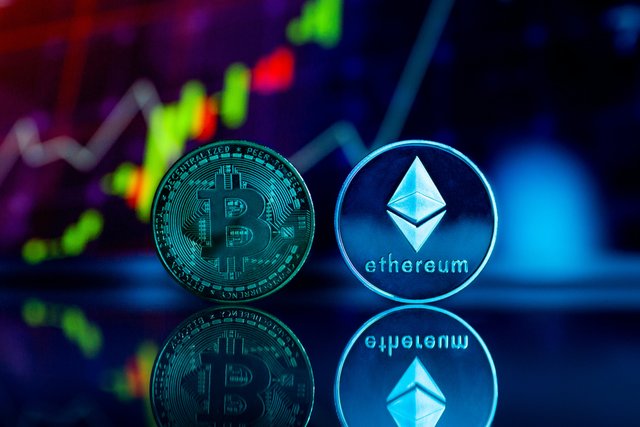
I sincerely hope that everyone enjoys the educational themes of the Steemit Engagement Challenge S13-W5. subsequently, the competitors' epic entries under the designated subject. I was eager to learn more about this new topic, so I did some research and shared my own opinions with you all. I hope that my contribution will also be valuable.
A secondary framework or protocol constructed on top of a primary blockchain, referred to as Layer 1, is referred to as Layer 2 in a blockchain. The primary blockchain network, such as Ethereum or Bitcoin, is Layer 1. By managing certain transactions off-chain, Layer 2 solutions seek to improve the underlying blockchain's scalability and efficiency while lowering expenses and congestion.

Technologies like sidechains, state channels, and plasma chains are examples of layer 2 solutions. By processing some operations outside of the main blockchain while keeping a connection to it for security, they make transactions faster and less expensive.
So we can say that The main blockchain is called Layer 1, and a supplemental framework called Layer 2 is meant to process transactions off-chain in order to increase scalability and performance.
Yes, so here are a few instances of Layer 2 solutions in the real world:
- State Channels: The Bitcoin Lightning Network.
Is the impractice example of layers 2 solution in the real world. With state channels, two parties can only open and close a channel on the main blockchain, but they can conduct multiple transactions off-chain.
These off-chain transactions have smaller fees and happen instantly. Next, the channel's final state is documented on the blockchain.A Layer 2 solution for Bitcoin that makes microtransactions quicker and less expensive is called the Lightning Network.

- Plasma:such as the Ethereum-based OMG Network.
With the help of the Plasma framework, a hierarchy of linked sidechains—each capable of handling its own transactions—is created. Users are able to transfer assets between the main chain and the sidechains, and the main blockchain (Layer 1) serves as a security layer.
The OMG Network uses Plasma technology to improve scalability as a Layer 2 scaling solution for Ethereum.Layer 2 solutions address scalability issues by shifting transactions off the main blockchain, maintaining security and decentralization of the underlying Layer 1 blockchain, enabling faster and more affordable transactions.
Through the following mechanisms, Layer 2 solutions aid in reducing transaction fees on a blockchain and promoting interoperability.
Certain transactions can be handled off-chain thanks to Layer 2 solutions like state channels and sidechains. Lower fees and quicker transaction times result from this reduction in the total transaction load on the main blockchain Layer 1.
Before interacting with the main blockchain, Layer 2 solutions frequently enable the aggregation of multiple transactions into a single batch. This batching method reduces the cost per transaction while maximizing the use of resources.

Certain Layer 2 solutions, such as cross-chain platforms, facilitate communication between various blockchains in order to emphasize interoperability. The seamless transfer of assets and data between blockchains is made possible by this, improving the decentralized ecosystem's overall connectivity.
Layer 2 solutions reduce congestion on Layer 1 by processing transactions off-chain or more scalable. This improves the blockchain network's overall scalability and reduces transaction fees.
Hence we can say that , By streamlining transaction processing, enhancing scalability, and promoting interoperability across multiple blockchains via a variety of protocols and technologies, Layer 2 solutions help lower fees. Together, these developments improve the effectiveness and usability of blockchain networks.
The underlying layer on which the Steem blockchain runs is commonly referred to as Layer 1. The Delegated Proof-of-Stake (DPoS) consensus algorithm is exclusive to Steem. As "witnesses" or "delegates," a group of elected nodes are in charge of validating transactions and creating new blocks in DPoS.
Transactions and interactions are made easier by the Steem blockchain and its DPoS layer in the following ways.
- Transferred Proof-of-Stake:
To verify transactions and create blocks in DPoS, the Steem community elects a set number of delegates. These delegates alternately produce blocks, and a democratic voting process is used to reach a consensus.
- Quick Block Manufacturing:
The Steem blockchain processes transactions rapidly because there are only a finite number of elected delegates and blocks are produced quickly—three seconds, on average. This makes the user experience more effective and responsive.

- Distribution of Credits for Resources
The resource allocation mechanism used by Steem is based on Resource Credits. In order to influence the network or carry out transactions, users on the Steem platform must possess a certain quantity of Steem Power, a type of token. By ensuring that those who have invested in the platform have a proportionate influence, this mechanism helps prevent abuse.
- Combined Decentralized Social Elements:
The goal of the Steem blockchain is to create a decentralized social network. Users can communicate with one another by sharing, upvoting, and commenting. By providing incentives for content creation and curation, the reward system promotes community engagement.
Hence we can interpret that the DPoS consensus algorithm powers the Steem blockchain's internal operations on a separate layer. By enabling quick transaction processing, resource distribution via Resource Credits, and a special content reward scheme, this layer builds a decentralized social network that incentivizes user engagement.
On the Steem blockchain, integrating a Layer 2 solution may have the following implications .
- Stability and Cost
Layer 2 solutions enhance scalability by processing transactions off-chain, enhancing transaction processing on the Steem blockchain, allowing faster interaction and content distribution among users.

Lower transaction costs for Steem platform users could be achieved through a Layer 2 solution, allowing them to participate in content creation, curation, and transfers more economically.
- Enhancement in Resource Allocation
Using resources more effectively is a common component of layer 2 solutions. Better resource management may be felt by users, particularly if batch processing or more efficient handling of microtransactions are part of the Layer 2 solution.
- Acceptance and Compatibility
Some Layer 2 solutions focus on interoperability, enabling communication between different blockchains. Integration of such solutions could open up possibilities for interoperability with other blockchain networks, potentially expanding the ecosystem and user base.
- Participation of the Community and Developers
Adding Layer 2 solutions could encourage developers to build services and apps on top of the Steem blockchain because of its increased scalability, which makes it more user-friendly.
On the behalf of this research I have acknowledged that the ramifications of Layer 2 solutions on blockchain platforms like Steem depend on their features, community acceptance, and consensus, but incorporating them could improve scalability, reduce costs, and enhance user experience.
https://twitter.com/UShaharyaar/status/1725178211607155089?t=xL2rhv3H7TOZT4ixI5PLGw&s=19
Downvoting a post can decrease pending rewards and make it less visible. Common reasons:
Submit
Upvoted. Thank You for sending some of your rewards to @null. It will make Steem stronger.
Downvoting a post can decrease pending rewards and make it less visible. Common reasons:
Submit
Hello friend.
You have well represented your post and I like the presentation. You have explained about Layer 2 Blockchain in your own words and in simple words which makes it very easy to understand for every Steemian.
True. Layer 2 solutions improve the scalability and flexibility of the blockchain and also reduces the transaction fees and It also results in faster transaction.
I appreciate your efforts. Good Luck for the contest.
Downvoting a post can decrease pending rewards and make it less visible. Common reasons:
Submit
Thanks dear for deep reviewing and shared you own perspective on my participation. Good luck to you
Downvoting a post can decrease pending rewards and make it less visible. Common reasons:
Submit
I appreciate the real world examples making it easier to grasp. and your insights on the potential impact of Layer 2 On the Steem platform are insightful. Best of luck
Downvoting a post can decrease pending rewards and make it less visible. Common reasons:
Submit
Thanks for reviewing and valuable feedback. Good luck to you.
Downvoting a post can decrease pending rewards and make it less visible. Common reasons:
Submit
Assalamualaikum sister @uzma4882,
Aik bohat achi post, me apky research work ki tarif krta hun or secondly, apny har chez ko aik balanced way me explain kiya ha. Ye bat bilkul durust ha k layer 2 ko aik existing Blockchain py implement krny sy main chain ki Scalability me kafi had tak behtari hoti ha.
Or ye behtri is sorat me hoti ha main chain sy ziada tar transactions k load ko layer 2 chain py transfer kr diye jata ha or is sy TPS me kafi had tak behtri ati ha.
Apki post ki tarif krty huy me apki kamyabi ki dua krta hun. Mene b post share ki ha, visit kr k apna keemti tabsara krna ha bholye ga. Good luck 🤞
Downvoting a post can decrease pending rewards and make it less visible. Common reasons:
Submit
La clave de la solución de la mayoría de los problemas de las blockchains que utilizan una capa está en mejorar la escalabilidad, reducir los costos y tiempos transaccionales. De allí nace la necesidad de crear soluciones alternativas fuera de la cadena principal como las blockchains de capa 2.
La descentralización ha sido el mecanismo más eficiente que se ha demostrado en el tiempo. Por eso fue genial que Steem mantenga su sistema descentralizado, siendo una de las blockchains más eficientes en términos de escalabilidad.
Saludos y muchos éxitos, amigo.
Downvoting a post can decrease pending rewards and make it less visible. Common reasons:
Submit
I strongly agree with you on this point. Adding a layer two solution will improve its status as decentralized social network.
Thanks for being this point out through your article.
Downvoting a post can decrease pending rewards and make it less visible. Common reasons:
Submit
Umid karta hun kya aap theek se hongi. Aapane is post ke har question ko bahut acchi Tarah se explain Kiya hai aur har topic ko hamesha ki Tarah acche se explain karne ki koshish ki hai iske alava aapane side change aur plasma change ke bare mein real world example byan ki hai joke qabil-e-tareef hain. Meri taraf se aap ki kamyabi k liyee bahut sari duaaen Hain.
Downvoting a post can decrease pending rewards and make it less visible. Common reasons:
Submit